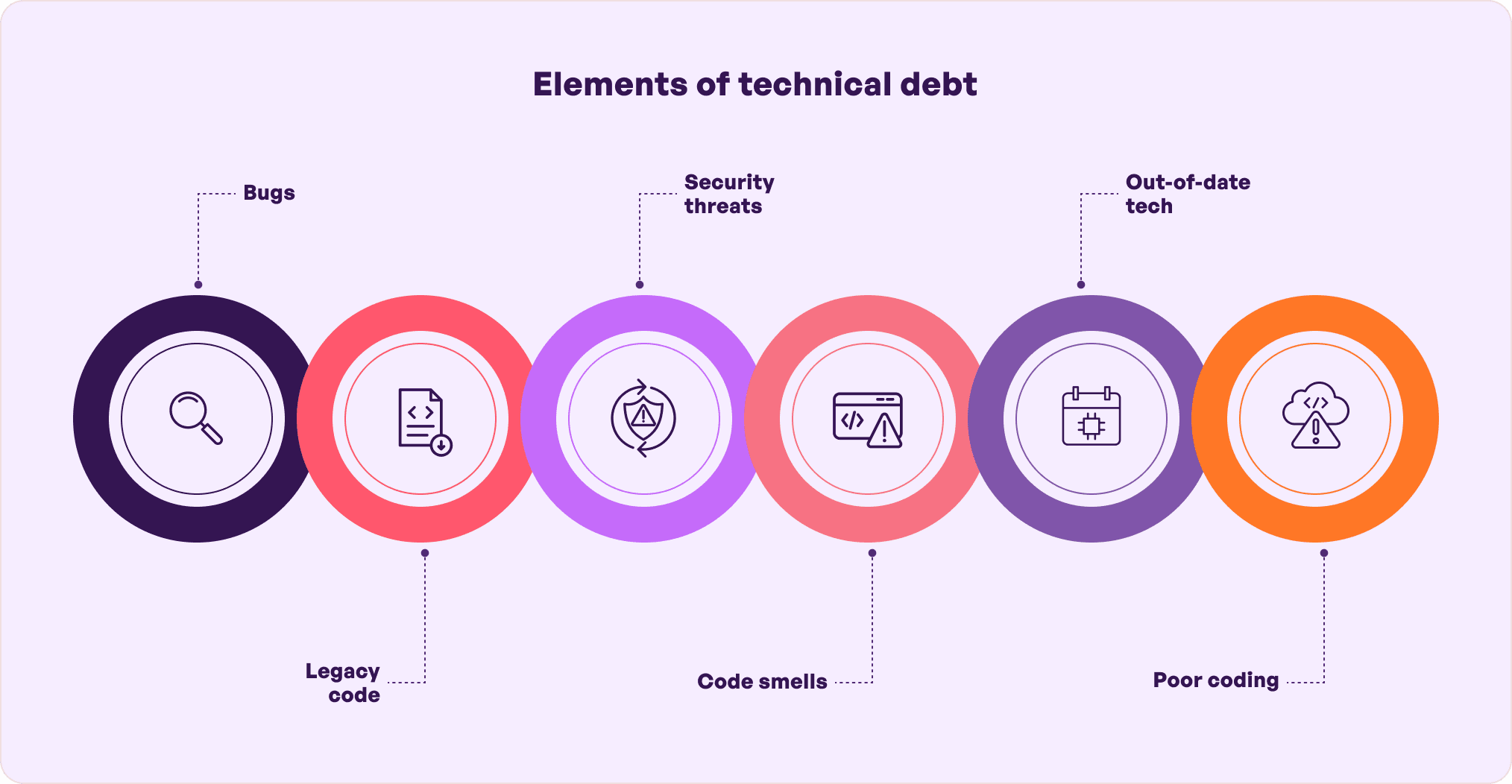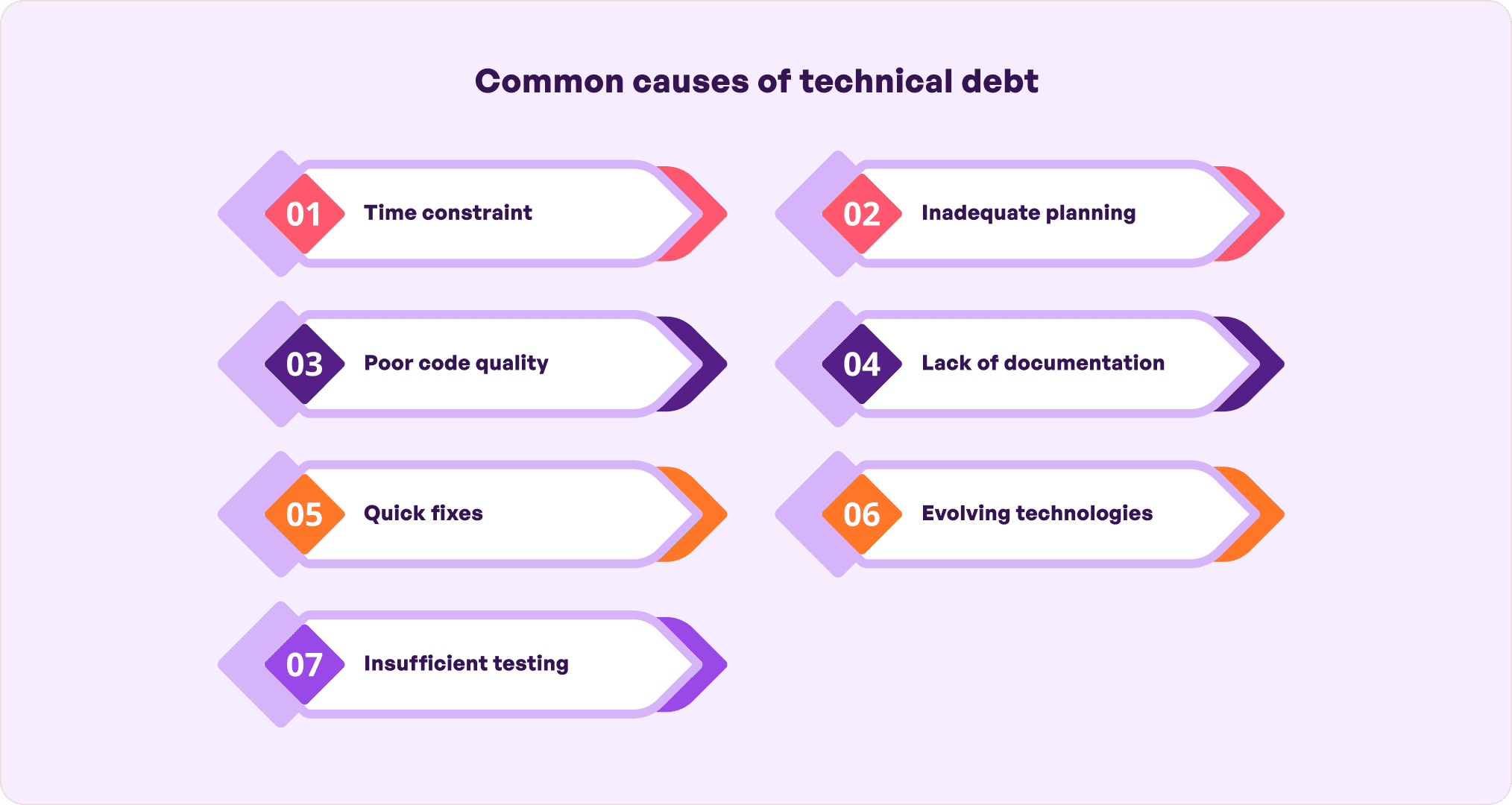Building a skyscraper on a shaky foundation – doesn’t it feel like a strange idea? Well, that’s because eventually the cracks will show. This is exactly what technical debt more or less feels like in the world of software development. Small yet significant unresolved issues like bugs and legacy codes and shortcuts are taken to tick off deadlines. While it does not feel quite critical at first, over time, technical debt slowly piles up and can hamper innovation, inflate costs, and jeopardize a business’ long-term success.
Studies found that 91% of senior business executives across the globe experienced technical debt as the biggest challenge at the beginning of 2024 and thus placing it as a major cause of concern for which robust technical debt reduction strategies must be in place to secure the possibilities of business innovation and growth.
Let us learn about the event in detail to build a scalable solution that meets user needs. Read on.
Table of contents
What is technical debt?
Technical debt occurs when immature codes are pushed through pipelines to speed up delivery and achieve short-term results, meet pressing project deadlines or, simply to save time and money instead of focusing on quality. When left unchecked, issues like sensitive customer data exposure, missing documents, code smells, and security threats and system malfunctions start piling up leading to additional revision costs.
 Further, technical debt occurs when technologies are not timely upgraded, usually due to lack of code testing, and as a result, multiple parallel code developments gets done at once. These make future improvements and fixes harder and complications end up hiking the support costs.
Further, technical debt occurs when technologies are not timely upgraded, usually due to lack of code testing, and as a result, multiple parallel code developments gets done at once. These make future improvements and fixes harder and complications end up hiking the support costs.
It is almost like taking a loan of both time and money to achieve maximum today and repaying it down the line – the process is nothing less than risky and frustrating. So, this makes it mandatory to have the best practices in place, like mitigating tech debt through QA to be able to cushion the time losses.
What are the types of technical debts?
There are multiple types of technical debt, each one of them stemming from different sources and having unique impacts on software projects. They can be widely categorized based on the visibility, cause, and impact on the codebase.
1. Code debt
This issue refers to unoptimized or poorly written codes that affect readability, performance, or scalability. Below are a few examples:
Extra complex code: These are code that are unnecessarily complicated which makes them hard to comprehend or modify.
Spaghetti code: Highly tangled and interdependent code with tough maintenance.
2. Design debt
These occur due to poor architectural decisions or lack of adherence to standard design principles. Below are a few examples:
- Inflexible architecture: This is typically a software design that does not allow for easy or quick scaling.
- Violation of principles: Ignoring principles of good object-oriented design which means single responsibility or dependency inversion.
3. Documentation debt
This debt is basically because of missing or incomplete documentation which ultimately makes it difficult to understand or use the code in the future. Below are a few examples:
- Lack of API documentation.
- Outdated project documentation.
4. Testing debt
The main reason behind this is Insufficient or inadequate test coverage that leads to undetected bugs and makes refactoring risky. Below are a few examples:
- Missing unit or integration tests.
- Manual test reliance rather than automated test suites.
5. Build and infrastructure debt
This debt is when problems in the build and deployment pipeline slow down development or increase the risks of errors. Below are a few examples:
- Lack of continuous integration/continuous delivery (CI/CD).
- Inefficient or fragile build processes that frequently break.
6. Process debt
Inefficient or poorly defined development processes that slow down the development cycle or create bottlenecks give rise to this debt. Below are a few examples:
- Inefficient code review processes.
- Inconsistent or unclear communication between teams.
7. People debt (knowledge debt)
This is when knowledge about a project is concentrated among a few team members, creating a dependency on those individuals. Below are a few examples:
- Only one person knows how a particular subsystem works.
- Lack of clear documentation of decision-making or reasoning for key design choices.
8. Architecture debt
Suboptimal decisions made during the initial phases of architecture design causes this debt which eventually turns into poor performance, minimal scalability, and low adaptability. Let us look at examples:
- Preferring monolithic architecture when a microservices approach is more appropriate.
- Poor database design causing severe performance bottlenecks.
9. UX/UI debt
When the user interface or user experience is neglected or hurried, a UI UX debt occurs resulting in a product that is difficult to use or quite unpredictable in behavior. Here are a few examples:
- Inconsistent user interface design elements.
- Lack of attention to usability or accessibility.
10. Security debt
This is due to cybersecurity vulnerabilities or neglected security measures in the software which could lead to future data breaches and non-compliance to established parameters. Below are a few examples:
- Hardcoded credentials or weak encryption methods.
- Lack of regular security audits or failure to patch known vulnerabilities.
11. Configuration debt
Bad configuration management often causes inconsistencies or errors during deployment between environments like staging, development, and production leading to this debt. Look at a few examples:
- Hard-coded environment-specific configurations.
- No infrastructure-as-code (IaC) practices.
12. Versioning debt
Issues related to version control, such as dependencies on outdated libraries or tools that are no longer supported are the top causes of this debt. Below are a few examples:
- Using deprecated libraries or unsupported frameworks.
- Lack of maintenance of APIs backwards compatibility.
Technical debt comes in many forms like below average processes, poorly written codes, and security flaws. Identifying and addressing these types early is crucial to ensure software quality and avoiding long-term inefficiencies. Let’s see how to get started.
This is when Simublade, an industry-leading QA testing company, can help with best tech combinations and approaches so that your software performs exceptionally well. It will include rigorous tests like automation, load, system, usability, security, and functional testing which helps eliminate the risks of technical debt.
What are the common causes of technical debt?
Technical debt arises when software development teams prioritize short-term goals over long-term code quality. Below are some common causes to know to be able to dodge them as and when possible and reduce the risks of capital loss.

1. Time constraints
- Tight deadlines: When developers are under pressure to deliver quickly, they may take shortcuts in code quality, resulting in poorly structured or undocumented code.
- Skipping best practices: To meet immediate goals, development teams may bypass essential processes like code reviews or proper testing.
2. Inadequate planning
- No initial design: Rushing into development without building a solid architecture leads to complications later on which require rework or extra complexity layers.
- Inadequate requirement analysis: If requirements are unclear or are constantly changing, it can result in multiple revisions of the code which is ultimately quite complex in nature.
3. Poor code quality
- Legacy code: Continuing to build on outdated or poorly written codes, like legacy codes, without refactoring leads to increased complexity over time.
- Code duplication: Reusing code in an improper way, without modularization, can make the codebase harder to maintain.
4. Lack of documentation
- Outdated documentation: When code lacks robust documentation, new developers struggle to understand it which causes inefficient solutions and ultimately more debt accumulation.
5. Quick fixes
- Temporary solutions: Implementing hacks to resolve immediate issues without addressing the root cause can create technical debt which needs to be addressed later in time.
- Workarounds: Short-term workarounds turning into permanent solutions cause long-term and serious technical debt.
6. Evolving technologies
- Obsolescence: As and when technology evolves, obsolete tools or methods become outdated which makes the codebase difficult to update or maintain without significant rework.
- Incompatibility: Implementing brand new frameworks or technologies without fully knowing their implications can create integration issues.
7. Insufficient testing
- No automated testing: Without comprehensive automated tests, usually go unnoticed leading to hidden technical debt that needs to be addressed later.
- Skipping unit and integration tests: Neglecting these tests can result in fragile systems that are prone to breaking with every change.
While a technical debt offers benefits right away, addressing it and maintaining a disciplined approach to software development can significantly reduce the impact of technical debt in the long term.
Have a look at the impact of technical debt which directly emphasizes on why management of the same must be a business’ top most priority.
5 core side effects of technical debt
Technical debt only provides short-term benefits like quicker delivery but often results in long-term costs that affect the sustainability and quality of a software project. Here are five significant side effects:
1. Lowered productivity
Developers spend more time navigating complex or poorly written code which hinders their efficiency. This causes long hours of development cycles and increases the effort required for future tasks.
2. Higher maintenance costs
Maintaining the codebase becomes increasingly costly as technical debt accumulates. Further, regular bug fixes, refactoring, and patchwork solutions add up leading to rising expenses.
3. Reduced software performance
Quick fixes and inefficient designs cause performance bottlenecks which slows the system slower and makes it less responsive. Users may start experiencing delays or crashes which ends up harming the product’s reputation.
4. Scaling difficulty
It is no surprise that systems with high technical debt often struggle to scale. This is due to the code not being flexible enough to accommodate growing user bases or new features which ultimately leads to major rework.
5. Decreased developer morale
Working with outdated, cluttered, or difficult-to-maintain code can be frustrating for developers. This frustration can lower morale, leading to lower productivity, burnout, or increased turnover.
Given the side effects are severe, it is critical for businesses to have a clear idea of technical debt reduction strategies for long-term business health.
How to mitigate technical debt – the best coding practices
Mitigating tech debt through QA is the most effective practice and is particularly necessary to be able to release successful software at once. This helps businesses avoid wasting money while staying afloat in the cut-throat competitive landscape. Let us see a few other ways in which technical debt could be tackled.
1. Emphasize code quality
Maintaining high-end code quality is crucial to mitigate technical debt.So, start by considering practices like writing crisp, readable, and well-documented code. Adhere to coding standards and guidelines to ensure consistency which also makes it easier for other developers to understand and work with the codebase. Regular code reviews and pair programming can also further catch issues early and promote compliance to best practices.
2. Implement automated testing
Wondering how automated testing reduces technical debt in software? Well, it is an extremely powerful tool for managing technical debt by creating a comprehensive unit, integration, and end-to-end tests to detect issues early in the development process.
This reduces the likelihood of bugs slipping through and ensures that changes to the codebase don’t introduce new problems. Over time, continuous integration (CI) systems that automatically run tests help maintain code quality.
3. Adopt modular design
Modular design involves breaking down the codebase into smaller and reusable components or modules. This approach enhances maintainability and scalability, making it easier to update or replace parts of the system without affecting the whole. Adopting principles like single responsibility and separation of concerns helps keep modules focused and reduces complexity.
4. Prioritize refactoring
Regular refactoring is essential for addressing and preventing technical debt. Refactoring involves restructuring existing code to improve its structure and readability without altering its functionality. By regularly revisiting and improving the code, you can reduce technical debt and make the system more adaptable to future changes.
5. Maintain comprehensive documentation
Solid documentation is vital for managing technical debt. Ensure that your code is well-documented with comments explaining the purpose and functionality of complex sections. Additionally, try to maintain up-to-date documentation for APIs, design decisions, and architectural patterns. Comprehensive documentation helps new developers understand the codebase and reduces the risk of introducing errors when making changes.
Role of quality assurance in minimizing tech debt
Quality assurance is integral to easing technical debt by identifying and addressing issues early, ensuring consistent standards, providing valuable feedback, supporting refactoring efforts, and facilitating comprehensive testing. By incorporating QA practices into the development process with the help of top notch companies like Simublade, businesses can effectively manage technical debt and ensure a higher-quality and maintainable software.
Let us see how technical debt management through testing is achieved.
1. Identifying and addressing issues early
Quality assurance sessions play a crucial role in identifying and addressing issues early in the development process. By thoroughly testing the software before release, QA teams can catch bugs, performance issues, and inconsistencies that might contribute to technical debt. Early detection prevents these issues from accumulating and becoming more complex and costly to fix later.
2. Ensuring consistent standards
QA sessions help ensure that the code adheres to established quality standards and best practices. QA professionals evaluate the software against predefined criteria and requirements, ensuring that it meets the necessary quality benchmarks. This helps maintain a high standard of code quality thus reducing the likelihood of introducing technical debt through poor practices or inconsistent implementation.
3. Providing feedback for continuous improvement
Testers typically provide valuable feedback during QA sessions about areas of the code that need improvement. This feedback loop allows developers to address issues, refine their code, and make necessary adjustments before the software reaches the end-users. By incorporating this feedback, developers can reduce technical debt and enhance the overall quality of the software.
4. Supporting refactoring efforts
QA sessions support refactoring efforts by validating changes made to the codebase. Now, when developers refactor code to improve its structure or performance, QA teams ensure that these changes do not introduce new issues or regressions. This helps maintain code quality while addressing technical debt and making the software more maintainable.
5. Facilitating comprehensive testing
QA sessions involve comprehensive testing, including functional, regression, and performance testing. This thorough approach helps identify and resolve potential technical debt by ensuring that all aspects of the software are thoroughly evaluated. Comprehensive testing usually lowers the risk of overlooked issues and ensures that the software performs reliably under multiple conditions.
These are the best QA practices to minimize technical debt accumulation and must be outsourced to a trusted third party service provider for the best results. Below is an idea of what it takes for the same.
Time, resources, and cost to overcome technical debt
Overcoming technical debt is a multifaceted process that needs precise planning and allocation of significant time, resources, and budget. The extent of these requirements will usually vary based on the complexity of the debt and the current state of the codebase.
1. Time required
- Analysis and prioritization: Identifying and prioritizing technical debt can take many weeks depending on size and complexity of the codebases. It involves conducting code reviews, analyzing technical debt reports, and consulting with business stakeholders for the ultimate decision.
- Refactoring and fixes: Addressing technical debt through refactoring, bug fixes, and other improvements can extend up to several months. The time needed depends on the scope of changes required, the number of affected components, and the overall level of documentation and testing involved.
- Ongoing maintenance: Continuous monitoring and maintenance to manage and prevent further technical debt is an ongoing process. This is because it involves regular code reviews, updates, and adjustments as and when new issues arise.
Below is an estimate of how much time it might take for different projects.
- Small projects: A few weeks to a couple of months.
- Medium projects: Several months to a year.
- Large projects: One year or more with potentially phased approaches.
2. Resources
Quality assurance professionals are crucial for testing and validating changes to ensure that fixes do not bring about new issues.
- Development team: Developers with expertise testing, code refactoring, and performance optimization are extremely essential. The team size will depend on the complexity and volume of the technical debt.
- Project management: Effective project management is mandatory to oversee the process, coordinate efforts, and ensure alignment with business goals.
- Tools and software: Investing in robust tools for code analysis, automated testing, and continuous integration will enhance efficiency in managing technical debt.
3. Cost estimates
- Small debt: $5,000 to $20,000
- Medium debt: $20,000 to $100,000
- Large debt: $100,000 to $500,000+
Conclusion
As technology continues to evolve at an accelerating pace, the nature of technical debt will transform side by side. Future advancements in artificial intelligence, machine learning, and automation are all set to revolutionize how businesses manage and mitigate tech debt.
The focus will primarily be on prevention with the help of a professional QA team with advanced comprehensive automated testing, design principles, and an emphasis on scalable and modular architectures. Finally, the future of technical debt management will be characterized by a shift from reactive to proactive strategies by leveraging technological innovations to enhance software quality and productivity.
FAQs
Q. What is technical debt and how does it accumulate?
Ans. Technical debt is the long-term consequences of taking shortcuts during software development to tick-off short-term gains, such as faster delivery or meeting deadlines. It accumulates due to time pressure, poor code quality, lack of planning, and outdated technologies.
Q. How can quality assurance help mitigate technical debt?
Ans. Quality assurance and technical debt go hand in hand since QA helps mitigate the issue by identifying issues early through thorough testing and ensuring that code meets quality standards thus minimizing the accumulation of bugs and inefficiencies.
Q. What are some key QA practices to reduce technical debt?
Ans. Key QA practices to reduce technical debt are automated testing to catch issues early and ensuring comprehensive code reviews.
Q. How does technical debt affect long-term software maintenance?
Ans. Technical debt will lead to codebase complexity which makes long-term software maintenance highly time-consuming and expensive. It will further lead to frequent bugs, slower development cycles, and hiccups while implementing new features.





